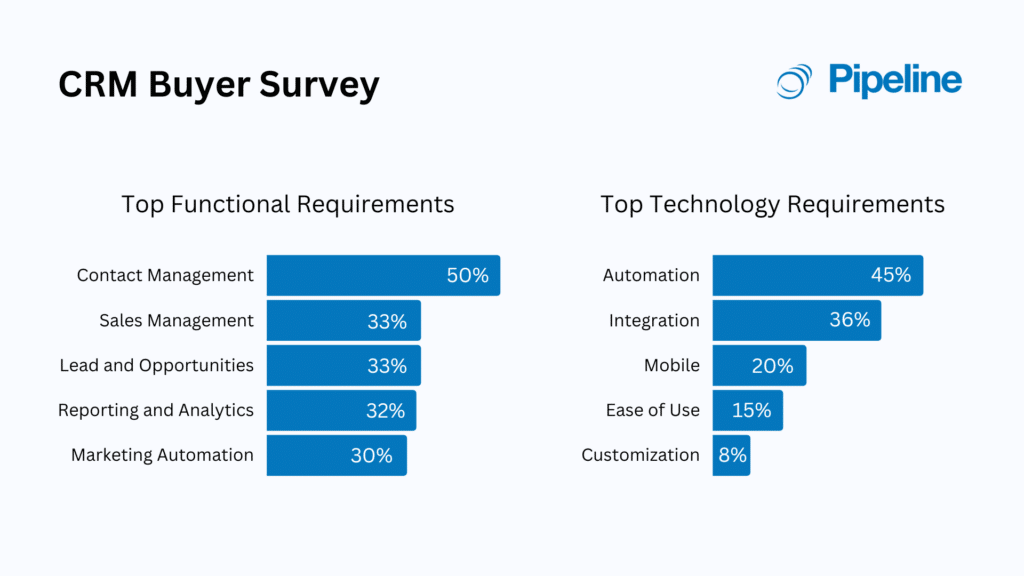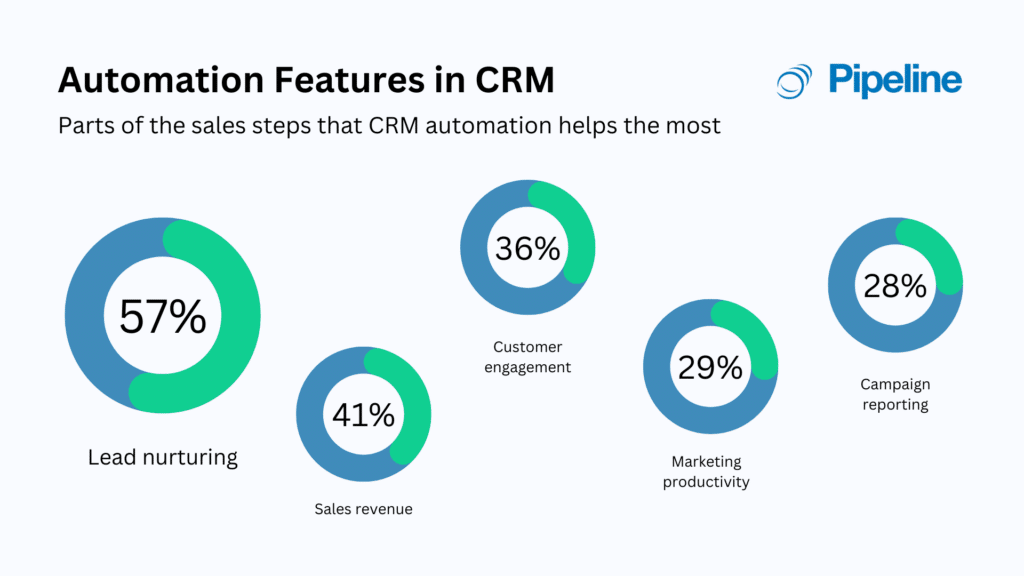In today’s constantly evolving business landscape, staying current on the latest Customer Relationship Management (CRM) trends and insights is critical.
Here are 15 key CRM statistics carefully selected and verified by our team to help you stay ahead of the competition (updated in 2024).
General CRM Statistics
1) 12.6% year-on-year (YoY) growth of CRM adoption
According to Gartner, at the end of 2017, the revenue of CRM overtook the place of database management systems (DMBSs), making CRM the largest software market in the world. Then, in 2018, with 16% growth, CRM easily became one of the fastest-growing software and leads the market until today (2024). In fact, with a 13.4% growth rate from 2023 to 2032, the revenue of CRM software is predicted to reach over $80 billion by 2025.
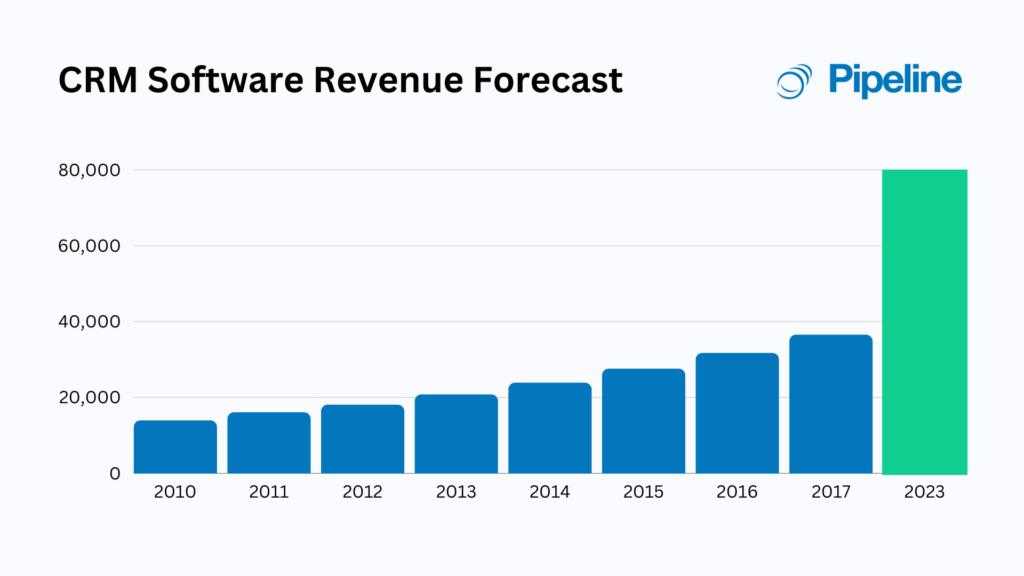
This substantial growth is not without reason. More and more startups emerge every year, filling the market with new players and bolder products/services, sales teams need a reliable sales hub that can sync all sales touch points wherever they are.
2) 44% of customers ignore unprepared sales pitches
Sales teams aren’t the only ones that were affected by this increasing wave of new products, but buyers too. Not only are buyers a tough audience by nature (60% of customers say ‘no’ four times before saying ‘yes’ to a pitch), they are now getting more sensitive to a sales approach. They won’t be reluctant to ignore cold calls, marketing emails, or business proposals if their criteria aren’t met.
44% of survey respondents share that they will immediately turn down a sales pitch if the sales representatives haven’t done thorough research on their company and needs, while 33% think receiving too many calls and emails are deal killers.
3) 43% of buyers think impression matters
So, when the “common” sales tactics are futile, how do you make a sales pitch work?
43% of the respondents say they will likely select a sales professional’s company as a vendor if they have a favorable impression when meeting with the sales reps. Another study claims 59% of customers consider tailored engagement as the crucial key to gaining their attention.
This means salespeople need to do their homework before a meeting, such as finding the prospect’s pain points, knowing which features of their products/services are effective in solving their problems, and anticipating any issues that may arise during the negotiations.
This shift in the buyer’s behavior pushes businesses to implement a sales tool like CRM into their daily work—helping them put buyer satisfaction above anything else.
| 77% of sales professionals say their organization plans to invest more in sales intelligence tools—including CRMs. This will help them reduce the time they spend on administrative and non-selling duties, which amount to 30% of their time. |
CRM Usage Statistics
4) 70% of sales reps think CRM closes more deals
Switching from in-person to online meetings also creates another layer of challenges for salespeople closing deals. Within a limited time and contact constraints, they need to gain trust and demonstrate an understanding of the buyers’ needs. It’s no surprise that 54% of sales professionals rely on sales tools like CRM to build stronger relationships with buyers, which results in more closed deals.
| 70% of salespeople say CRM is very important to closing deals. |
5) More than 45% of CRM usage is for contact management and automation
Every sales professional knows the long and winding road it takes for a prospect to sign a deal. It demands a lot of research, approach attempts, negotiations, and follow-ups. This is where adopting a CRM becomes very helpful. With its many, and extensive functions (see the top CRM functions on the chart below), a CRM will help you accelerate and make the deal-closing journey less stressful.
Based on a CRM buyer survey, the top three problems that most companies want to solve from a CRM adoption are contact management (50%), sales management (33%), and lead generation (33%).
Additionally, they are also interested in having CRM software that can automate specific sales tasks and processes (45%), have numerous integrations (36%), and can well support their on-field workers (20%).
6) 57% of CRM automation is dedicated to lead nurturing
Another study also suggests the importance of automation in a CRM to help organizations in different areas of sales. They vary from lead nurturing (57%) to customer engagement (36%) to campaign reporting (28%). This is particularly important, considering more than eight of ten sellers claimed that they lost deals due to a key stakeholder leaving a prospect company.
CRM Users Statistics
7) 32% of businesses that use CRM are from the service industry
Looking at the many hats a CRM solution wears, it’s clear that CRM is suitable for any kind and any size of business. As long as your business engages with customers, a CRM will give you the upper hand in improving your sales performance.
That said, the services industry (32%), such as real estate, agencies, and construction companies, contribute to the biggest users of CRM by industry, followed by manufacturing and IT businesses (both with 13% share).
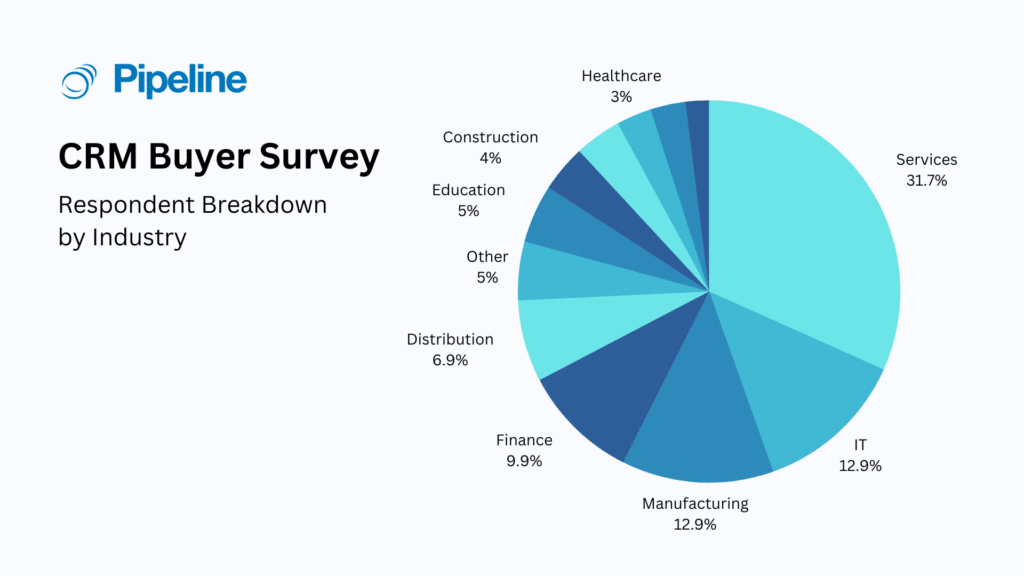
8) 65% of SMB businesses adopt a CRM within their first five years
According to Capterra, more than half of the companies that adopt a CRM started their business at least five years ago.
Furthermore, company size doesn’t dictate when a business adopts a CRM. The chart below shows that the employee count is fairly evenly distributed from companies that have 2-9 employees to those that have 100-499 employees.
These numbers are particularly interesting since many people believe that large companies are the ones that gain the most from CRM adoption. In reality, a two-person company also receives a tremendous boost in its business growth. By using a CRM, they can handle hundreds of leads without feeling overwhelmed because everything is neatly organized and trackable on the CRM system. CRM acts as an extra help that many small to medium businesses (SMBs) need.
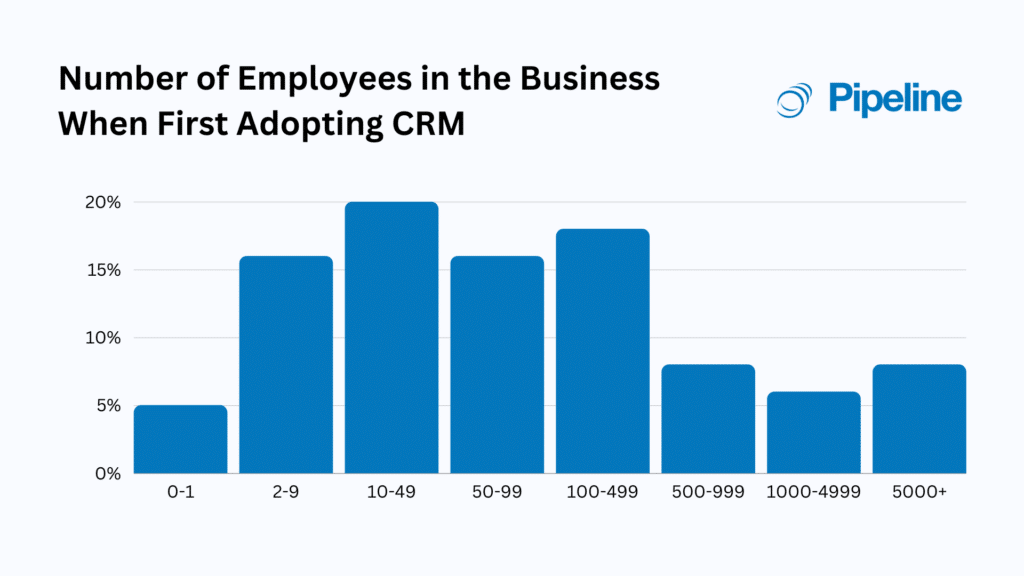
9) More than 45% of marketing and customer service teams also use CRM
CRM may be specifically designed to support sales activities. However, its users aren’t only limited to sales but also to other departments, namely marketing (46%) and customer service (45%).
That said, with more advancement in collaborative workflow, users of CRM are no longer exclusive to front-office employees but also back-office teams. For example, the finance/accounting department can have one-stop access to the revenue reports, the legal team can directly help with contract drafting, and the human resources (HR) team can generate objective performance reports.
CRM Benefit Statistics
10) 300% increase in lead conversion rate
36% of sales professionals feel deal closing is the most difficult part of the sales process—but with CRM, you can overcome this obstacle and even achieve a 300% increase in conversion rate. How can this happen?
Principally, CRM improves three main areas of your business: sales activity, team productivity, and company benefit.
- Sales activity: CRM allows salespeople to carefully classify and provide different sales treatments based on the leads’ value to the company—making every sales effort an effective one.
- Team productivity: As the team’s hub, CRM always puts every team member on the same page at every deal stage. Instead of working in silos, the team can share, add, and edit information in real-time. This will reduce internal communication and in turn, accelerate sales.
- Company benefit: With more on-target sales and marketing tactics, the company will spend less time acquiring new customers. And with more tasks and workflows set on automation, businesses will need fewer employees to hire. A big saving in time and money.
- Data integrity: CRM that is equipped with conditional formatting features empowers you to maintain clean and accurate data. In fact, 45% of salespeople feel their biggest data challenge is incomplete data. As a result, your outreach campaigns can be more on-target, reducing the total costs and bounce rate.
Related: Learn more about how clean data can increase sales performance in this guide.
| Note: These are only a few benefits of CRM adoption. You can get the full list along with some tips on how to choose the right CRM tool in our free CRM handbook. |
11) 47% growth in customer retention and satisfaction
CRM isn’t only useful to convert leads. It’s also a critical tool to retain existing customers. One survey finds companies that implemented a CRM experienced a 47% growth in both customer retention and satisfaction.
Once a lead becomes a customer, all their purchase activity and buying behavior are recorded in the CRM. Salespeople can then use this data to be proactive in keeping customers loyal to the brand.
For instance, by analyzing the buying cycles, you can predict their next order and offer freebies or special discounts to turn them into repeat customers. You can also see the items customers often buy together and use this insight for cross-selling opportunities and new marketing ideas.
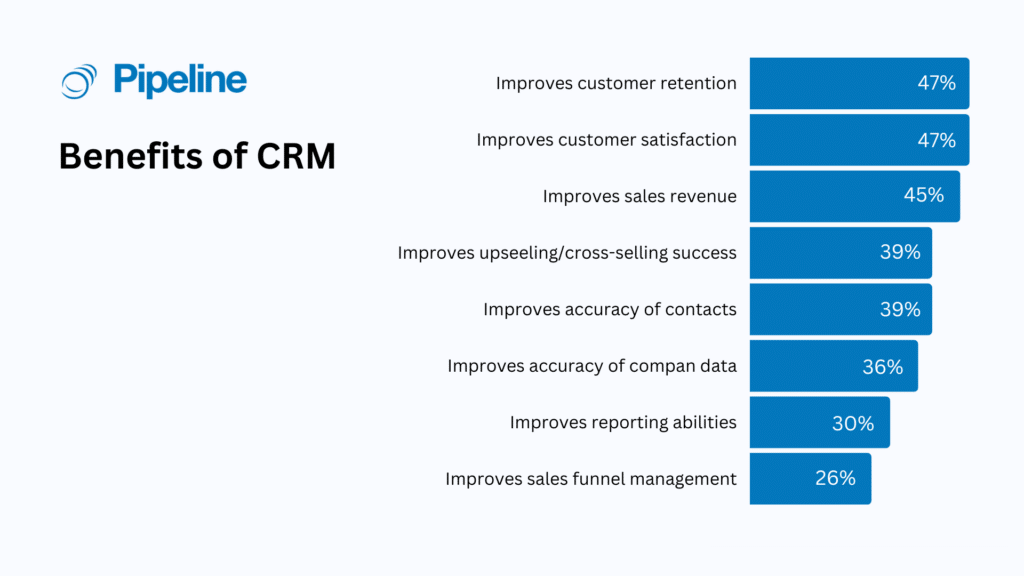
12) 8-14% of shorter sales cycles thanks to improved data accessibility
Although using spreadsheets and sticky notes come with many drawbacks, many sales reps are still stuck in this traditional method of data management, refusing to embrace a CRM. This approach may still work in managing small entries of customer data, but when you have hundreds of contacts, leads, and communication touchpoints that need to be updated daily, CRM is the tool you need.
| 74% of CRM users feel their CRM system gives improved access to customer data. |
CRM simplifies data management, and the reasons are no-brainers. With CRM, information is no longer stored in separate spreadsheets scattered across team members. The data collections now have uniform metrics that can be customized and attached with links, documents, and other related data types directly to the entry. Some CRMs even support automatic contact import from emails and social media accounts for a smoother workflow.
All these advanced contact and sales management features allow you to have an organized data management system that helps to minimize lost opportunities and shorten the sales cycles by 8-14%.
13) 50% of teams improved their productivity thanks to mobile CRM
Another feature that contributes to the success of CRM implementation is the mobile CRM. This is particularly useful for on-field workers (e.g., contractors and surveyors) and salespeople who still meet prospects face-to-face. Having easy access to data can increase productivity by 50%.
For example, mobile users can check important numbers before meetings, enter newly acquired information quickly, and reply to important messages even when they are on the go—enabling sales reps to impress their customers with fast and thoughtful responses.
14) 41% of increased revenue per sales professional
With higher conversion rates, more happy customers, and better sales workflow, it’s obvious that CRM surges the overall revenue of a business. One study shows that CRM helped to boost the profits generated by each sales representative by 41%.
15) $30.48 of investment payback for every dollar spent
In terms of return on investment (ROI), when we forecast the 1.5 times CRM ROI rate, CRM will pay back $45.72 (or more) for every dollar spent by businesses (2024). And the more fantastic news is that this profitable investment can be recouped in just six months or less.
Final Thoughts
Numbers never lie. From the gathered statistical data about CRM above, there’s no denying that CRM is a powerful tool that can help companies grow their businesses efficiently. CRM helps your salespeople work more productively and collaboratively in going that extra mile to make customers happy. In turn, they will feel appreciated, become loyal customers, and all your investment will be returned multiple times.
If you’re looking for a CRM solution that provides you with all these advantages and more, try Pipeline CRM. From customizing your CRM to automating tasks and deal steps—we help you turn your one-time buyers into repeat customers. Experience PipelineCRM now with just a few clicks.
